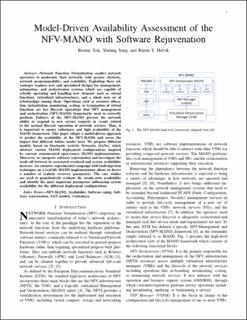Model-Driven Availability Assessment of the NFV-MANO with Software Rejuvenation
Peer reviewed, Journal article
Accepted version

Åpne
Permanent lenke
https://hdl.handle.net/11250/2825777Utgivelsesdato
2021Metadata
Vis full innførselSamlinger
Originalversjon
10.1109/TNSM.2021.3090208Sammendrag
Network Function Virtualization enables network operators to modernize their networks with greater elasticity, network programmability, and scalability. Exploiting these advantages requires new and specialized designs for management, automation, and orchestration systems which are capable of reliably operating and handling new elements such as virtual functions, virtualized infrastructures, and a whole new set of relationships among them. Operations such as resource allocation, instantiation, monitoring, scaling, or termination of virtual functions are key lifecycle operations that NFV management and orchestration (NFV-MANO) frameworks need to correctly perform. Failures of the NFV-MANO prevent the network ability to respond to new service requests or events related to the normal lifecycle operation of network services. Thus, it is important to ensure robustness and high availability of the MANO framework. This paper adopts a model-driven approach to predict the availability of the NFV-MANO and assess the impact that different failure modes have. We propose different models, based on Stochastic Activity Networks (SANs), which abstract various MANO deployment configurations, inspired by current containerized open-source MANO implementations. Moreover, we integrate software rejuvenation and investigate the trade-off between its associated overhead and system availability increase. An extensive experimental campaign with fault-injection techniques on a real-life MANO implementation allows to derive a number of realistic recovery parameters. The case studies are used to quantitatively evaluate the steady-state availability and identify the most important parameters influencing system availability for the different deployment configurations.